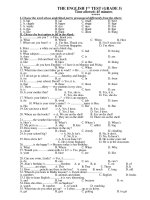- Trang chủ >>
- Mầm non - Tiểu học >>
- Lớp 2
Tải Đề cương ôn tập thi tuyển công chức giáo viên Tiểu học môn tiếng Anh - Nội dung ôn thi Công chức giáo dục
Bạn đang xem bản rút gọn của tài liệu. Xem và tải ngay bản đầy đủ của tài liệu tại đây (175.6 KB, 5 trang )
<span class='text_page_counter'>(1)</span><div class='page_container' data-page=1>
UBND TỈNH VĨNH PHÚC
<b>SỞ GIÁO DỤC VÀ ĐÀO TẠO</b> <b>CỘNG HÒA XÃ HỘI CHỦ NGHĨA VIỆT NAMĐộc lập - Tự do - Hạnh phúc</b>
<b>ĐỀ CƯƠNG</b>
<b>HƯỚNG DẪN ÔN TẬP DỰ TUYỂN CÔNG CHỨC GIÁO VIÊN TIỂU HỌC</b>
<b>MÔN: TIẾNG ANH</b>
<b>A. PHẦN THI KIẾN THỨC VÀ GIẢNG DẠY CẤP TIỂU HỌC</b>
<i><b>Khung trình độ: Trình độ tương đương với chương trình Cao đẳng sư phạm</b></i>
<i><b>Anh văn (trình độ B2 hoặc bậc 4).</b></i>
<i><b>I. KIẾN THỨC NGÔN NGỮ:</b></i>
<b>1. Ngữ âm:</b>
<i>Lưu ý: phát âm (pronunciation) và trọng âm của từ (word stress)</i>
<b>2. Từ vựng: Tập trung các chủ đề:</b>
- Family/ Friends
- House/ School
- Food/ Drink
- Hobbies
- Sports/ Games
- Travel and transport
- Jobs
- Education and learning
- Weather/ Environment
- Health and fitness
- Entertainment
- Holidays
- Clothes/ Fashion
- Nationalities
<b>3. Ngữ pháp:</b>
<i>3.1. Tenses (Các thì trong tiếng Anh):</i>
- Present time: present simple, present continuous, present perfect simple,
present perfect continuous
- Past time: past simple, past continuous, past perfect simple, past perfect
continuous, used to, get used to
- Future time: future simple, future continuous, future perfect simple, future
perfect continuous
<i>3.2. Articles (Mạo từ): A, an, the</i>
<i>3.3. Nouns: (Danh từ )</i>
- Countable and uncountable nouns (DT đếm được và không đếm được)
- Singular and plural nouns (DT số ít và số nhiều)
<i>3.4. Quantifiers (Lượng từ):</i>
Many, much, a lot of, a few, a little, …
<i>3.5. Adjectives (Tính từ)</i>
- Kinds of adjectives (Các dạng tính từ)
- Position of adjectives (Vị trí của tính từ)
- Order of adjective (Thứ tự của các loại tính từ trong câu)
<i>3.6. Adverbs (Trạng từ)</i>
- Types of adverbs (Các loại trạng từ)
- Form and use of adverbs (Cấu tạo và cách dùng trạng từ)
- Position of adverbs (Vị trí trạng từ)
<i>3.7. Conditionals (Câu điều kiện)</i>
</div>
<span class='text_page_counter'>(2)</span><div class='page_container' data-page=2>
- The first (Câu điều kiện loại một)
- The second (Câu điều kiện loại hai)
- The third (Câu điều kiện loại ba)
- The mixed (Câu điều kiện hỗn hợp)
- In case, as/so long as, provided(that)
<i>3.8. Comparision (Các dạng so sánh)</i>
- Positive (So sánh bằng)
- Comparative (So sánh hơn/kém)
- Superlative (So sánh hơn nhất)
- Double comparative (So sánh kép)
<i>3.9. So/such/enough/too</i>
<i>3.10. Prefer/would rather/had better</i>
<i>3.11. Modal verbs (Các động từ khuyết thiếu: can, will, should, …)</i>
- Ability (Khả năng)
- Permission (Sự cho phép)
- Advice (Lời khuyên)
- Obligation and necessity (Nghĩa vụ và sự cần thiết)
- Criticism (Sự phê bình)
<i>3.12. Passive voice (Thể bị động)</i>
- Form (Cấu tạo)
- Use (Cách sử dụng)
- Prepositions with passive verbs (Giới từ và động từ bị động)
<i>3.13. Indirect speech (Nói gián tiếp)</i>
- Tense and modal changes (Các thay đổi về thì và động từ khuyết thiếu)
- Pronoun and determiner changes (Các thay đổi về đại từ và từ hạn định)
- Time and place changes (Các thay đổi về thời gian, địa điểm)
- Reported questions (Các câu hỏi gián tiếp)
<i>3.14. Relative clauses (Mệnh đề quan hệ)</i>
- Defining clauses (Mệnh đề quan hệ xác định )
- Non – defining clauses (Mệnh đề quan hệ không xác định)
<i>3.15. Participles (Các dạng Phân từ):</i>
<i>- The present participle (Phân từ hiện tại – dạng ing)</i>
<i>- The perfect participle (phân từ hoàn thành – dạng Have done)</i>
<i>- The past participle (phân từ bị động – dạng ed)</i>
<i>3.16. Inversions (Các dạng đảo ngữ)</i>
- Với các trạng từ/cụm trạng từ mang nghĩa phủ định: Never, Rarely, Hardly,
Under no circumstances, …
- Các dạng đảo ngữ khác:
<i>+ Dùng với so, neither, nor</i>
<i>+ Dùng với so, as, such</i>
<i>+ Dùng trong câu điều kiện: Were…, Had …</i>
<i>3.17. Prepositions (Giới từ)</i>
In, on, at, next to, between, …
<i>3.18. Conjunctions (Liên từ)</i>
</div>
<span class='text_page_counter'>(3)</span><div class='page_container' data-page=3>
- Yes-No questions, Wh-questions
- Questions tags (Câu hỏi đuôi)
- Indirect questions (Câu hỏi gián tiếp): Do you know …? / I wonder
if/whether ….)
<i>3.20. Phrasal verbs (Cụm động từ)</i>
<i><b>II. KĨ NĂNG NGÔN NGỮ:</b></i>
<i><b>1. Kĩ năng nghe: Ôn luyện các dạng bài nghe:</b></i>
- Listen and complete the sentences/ passage/ dialogue.
- Listen and match
- Listen and choose the correct answers/ pictures
- Listen and answer the questions
<i><b>2. Kĩ năng đọc: Ôn luyện các dạng bài:</b></i>
- Read and complete a sentence, a passage or a dialogue.
- Read a passage and answer the questions or write T (true) or F (false).
- Read and choose the correct answers to complete a sentence or a passage.
<i><b>3. Kĩ năng viết: Ôn luyện các dạng bài viết:</b></i>
- Identify the mistakes (and correct) in a sentence or a passage.
- Rewrite a sentence with the word given without changing the meaning of the
sentence.
- Complete the sentences or a passage using the words given.
- Write a paragraph/ an essay:
+ Give your opinion (agree or disagree) with a statement.
<i>Example 1: Do you agree or disagree with the following statement: “Parents</i>
<i>always know what is best for their children”. Use specific reasons and examples to</i>
support your response.
<i>Example 2: Do you agree or disagree with the following statement: “A teacher</i>
<i>should always sick to the subject matter of the course”. Use specific reasons and</i>
examples to support your response.
+ Discuss about advantages and disadvantages of mobile - phone, television,
computer game, homework, extra teaching and learning, etc.
<i><b>III. PHƯƠNG PHÁP GIẢNG DẠY</b></i>
Cần nắm vững các kĩ năng/ kĩ thuật giảng dạy với từng dạng bài:
- Phương pháp dạy bài nghe
</div>
<span class='text_page_counter'>(4)</span><div class='page_container' data-page=4>
<i>( Tham khảo sách “Kĩ thuật dạy tiếng Anh cho học sinh Tiểu học – tác giả Nguyễn Quốc</i>
<i>Hùng, MA – Nhà xuất bản Giáo dục).</i>
<b>B. PHẦN THỰC HÀNH SOẠN GIÁO ÁN:</b>
<i><b>Giáo án soạn 1 tiết trong sách tiếng Anh 4 và sách tiếng Anh 5 của Nhà xuất</b></i>
<i><b>bản Giáo dục; tác giả Hồng Văn Vân (Tổng chủ biên).</b></i>
<b>I. Phân phối chương trình:</b>
- Mỗi khối lớp gồm 20 đơn vị bài học (20 Units)
- Mỗi bài học(Unit) gồm 03 phần (03 Lessons)
- Mỗi phần(Lesson) được dạy trong 2 tiết (02 Periods)
<b>II. Tham khảo mẫu giáo án:</b>
Giáo án một tiết học cần bao gồm các nội dung chính như sau:
<b>DẠNG BÀI DẠY KIẾN THỨC NGÔN NGỮ:</b>
<b>1. Aims/ Objectives:</b>
Sts will be able to: ….
<b>2. Language focus:</b>
- Structure (Sentence patterns): …
- Vocabulary: …
<b>3. Resources (Teaching aids):</b>
Books, recording, flash cards, …
<b>4. Procedures:</b>
<i>Cần chỉ ra: khoảng thời gian phù hợp cho mỗi hoạt động, nội dung cụ thể và cách</i>
<i>thức học sinh hoạt động (cả lớp/ nhóm/ cặp/ cá nhân)</i>
<i><b>Procedures</b></i> <i><b>Time</b></i> <i><b>Teacher’s activities Students’ activities</b></i>
<b>Warm up:</b>
Song/ Chant/ Game/ Activity … min(s) ……….. ………….
<b>Presentation:</b>
- Introducing the topic
- Introducing new language ……….. ……….. ………..
<b>Practice:</b>
- Controlled practice
- Freer practice ……….. ……….. ………..
<b>Production:</b>
Applying new language ……….. ……….. ………..
<b>Follow up (Reinforcement):</b>
Hoạt động, trò chơi để củng
cố, tăng cường ……….. ……….. ………..
<b>Homelink:</b>
Phần việc về nhà cho HS ……….. ……….. ………..
<b>DẠNG BÀI DẠY KĨ NĂNG NGÔN NGỮ:</b>
<b>1. Aims/ Objectives:</b>
Sts will be able to: ….
<b>2. Language focus:</b>
</div>
<span class='text_page_counter'>(5)</span><div class='page_container' data-page=5>
- Vocabulary: …
<b>3. Resources (Teaching aids):</b>
Books, recording, flash cards, …
<b>4. Procedures:</b>
<i>Cần chỉ ra: khoảng thời gian phù hợp cho mỗi hoạt động, nội dung cụ thể và cách</i>
<i>thức học sinh hoạt động (cả lớp/ nhóm/ cặp/ cá nhân)</i>
<i><b>Procedures</b></i> <i><b>Time</b></i> <i><b>Teacher’s activities Students’ activities</b></i>
<b>Warm up:</b>
Song/ Chant/ Game/ Activity … min(s) ……….. ………….
<b>Pre-stage:</b>
- Introducing the topic
- Explaining the language
- Setting the task
……….. ……….. ………..
<b>Through/While-stage:</b>
Doing the task
(Listen, read …) ……….. ……….. ………..
<b>Post-stage:</b>
- Reporting the task
- Applying the language in
new situations
……….. ……….. ………..
<b>Follow up (Reinforcement):</b>
Hoạt động, trò chơi để củng
cố, tăng cường ……….. ……….. ………..
<b>Homelink:</b>
Phần việc về nhà cho HS ……….. ……….. ………..
</div>
<!--links-->









